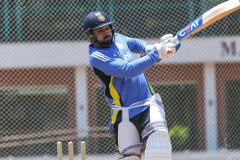Which Pitch is Good for Batting: Dead, Dusty, or Green? Understanding the Best Pitches for Batting and Bowling

Which Pitch is Good for Batting and Bowling?
A pitch that is ideal for batting typically offers consistent bounce, minimal seam movement, and no excessive turn. Such conditions allow batsmen to time their shots well and score runs with relative ease. Flat or "dead" pitches are often considered the best for batting due to their predictable nature.
On the other hand, a pitch that benefits bowlers usually has some grass or moisture, aiding swing and seam movement for pacers. For spinners, pitches with cracks or dryness, like dusty surfaces, provide turn and variation. While a perfectly balanced pitch is rare, it is often said that a slightly harder surface with mild assistance for bowlers can create an engaging contest between bat and ball.

Which Pitch is Better for Batting: Dead, Dusty, or Green? Why?
Among dead, dusty, and green pitches, the dead or flat pitch is undoubtedly the best for batting. The lack of grass and moisture ensures that the ball behaves predictably, giving batsmen the confidence to play their shots without worrying about unexpected movement. Such surfaces are common in limi=ted-overs formats, where high-scoring games are more frequent.
Dusty pitches, while initially manageable, become challenging as the match progresses. The increasing spin and uneven bounce can make it hard for batsmen to settle in. Green pitches, in contrast, favor fast bowlers, making batting a daunting task due to lateral movement and unpredictable bounce.
What are the different types of cricket pitches?
In cricket, the nature of the pitch plays a pivotal role in determining the outcome of a game. Understanding the characteristics of different types of pitches can help players, coaches, and enthusiasts evaluate which surfaces are best suited for batting. Cricket pitches are broadly divided into three types according to the characteristics of the surface:
Flat pitch (Dead/Flat Pitch): This type of pitch is usually not covered in grass and has a hard, dry surface. It is the most batsman-friendly as the ball bounces with consistent bounce and lacks spin or drift.
Turf pitches (Green Pitch): These pitches have more grass and are common in Europe and Australia. They help fast bowlers to take advantage of the swing and seam variations of the ball and are more challenging for batsmen.
Dusty pitches (Dusty Pitch): These pitches are common in subcontinental countries such as India and Pakistan. They are dry and soft, which is ideal for spin bowlers, but gradually becomes more difficult for batsmen.
Summary
Overall, flat grounds are most favorable for batters, as they provide stable bounces and precise conditions, allowing batters to play freely. However, sandy grounds and turf grounds provide greater assistance to spin pitchers and fast pitchers, respectively, and these two types of grounds pose greater challenges to batters. The choice of ground usually depends on the geographical location and climatic conditions of the playing venue, while the skill and adaptability of the batters determine whether they can achieve good results on different grounds.
QATs
Which pitch is good for batting in India?
In India, flat pitches are good for batting, but dusty pitches are more common, favoring spinners in the later stages of a match.
Is dusty pitch good for batting?
Dusty pitches are manageable early on but become challenging as they start assisting spinners.
Which pitch is good for batting: hard or green?
Hard pitches are better for batting as they provide consistent bounce, while green pitches are tough for batsmen.
Which pitch type is best for batting?
Flat pitches are the best for batting due to their predictable and batsman-friendly nature.
Related News
-
Top 15 Longest Sixes in Cricket History: From Shahid Afridi to Corey Collymore
cricket 23-Dec-2024 11:19
-
Top 10 Richest Cricketers in the World 2024-2025 (in Indian Rupees)
cricket 21-Dec-2024 14:06
-
How Many Double Centuries of Rohit Sharma in All Formats? A Deep Dive Into His Record
cricket 19-Dec-2024 13:45
-
What is the Meaning of an Innings in Cricket? Essential Knowledge for Beginners
cricket 18-Dec-2024 09:11
-
Which Team Has the Biggest Fan base in IPL History? Explore the Fan Followings of These Teams
Virat Kohli 18-Dec-2024 08:19
-
Cricket ka king kaun hai? Virat Kohli lives up to his reputation
cricket 11-Dec-2024 14:12
Latest News
-
RGD vs DAM Dream11 Prediction - Get Today Match Preview, Playing XI, Best Team Picks and Pitch Report
T20 Cricket 23-Dec-2024 12:49
-
KRM vs KUM Dream11 Prediction, Best Team Today Picks, Playing XI and Pitch Report for KCC T20 CAL
T20 Cricket 23-Dec-2024 12:23
-
BAW vs IRR Dream11 Prediction Today Match - Best Captain and Vice-Captain Picks, Playing XI, Pitch Report for Nature Isle T10 6th Edition
cricket prediction 21-Dec-2024 11:10
-
REN vs SCO Dream11 Prediction, Fantasy Cricket Tips, Dream11 Team Picks, Playing XI and Pitch Report for Australian T20 League
T20 Cricket 22-Dec-2024 07:40
-
South Africa vs Pakistan Match Prediction and Today Cricket Preview: Who will win SA vs PAK 3rd ODI?
SA vs PAK 21-Dec-2024 12:22
-
AM-W vs QUN-W Dream11 Prediction - 18th Today Match Fantasy Cricket Tips, Best Team Picks, Playing XI and Pitch Report
cricket prediction 20-Dec-2024 13:56



